Ever wondered how to create a living room that feels both serene and stylish, effortlessly blending simplicity with warmth? Japandi design has taken the interior world by storm, captivating homeowners with its perfect harmony of Japanese minimalism and Scandinavian coziness. Its appeal lies in fostering calm, clutter-free spaces that promote mindfulness and balance—ideal for today’s fast-paced lifestyles.
In this article, you’ll discover a treasure trove of inspiring ideas and practical tips to transform your living room into a Japandi haven. From choosing the right color palettes to incorporating natural textures and traditional Japanese touches, these suggestions will help you craft a space that embodies tranquility and elegance. Whether you’re starting fresh or simply looking to refresh your current decor, get ready to embrace a balanced, beautiful living environment.
A neutral color palette is the foundation of the serene, balanced Japandi style, transforming your living room into a peaceful retreat. These shades—think soft creams, warm beiges, muted greys, and gentle taupes—create a cohesive look that feels both calming and sophisticated. By sticking to these hues, you foster an environment that promotes relaxation and visual harmony, making your space feel open and inviting.
Visualize a living room with walls painted in a warm, matte beige, complemented by a plush, low-profile sofa in a light grey linen fabric. Natural wood furniture in honey tones adds warmth, while textured textiles, like a linen throw or wool cushions, introduce subtle depth. The overall effect is a tranquil space where the gentle interplay of muted tones and natural textures invites you to unwind. Soft lighting enhances the palette, casting a warm, cozy glow that amplifies the room’s serenity.
To recreate this look, start by choosing a palette of neutral paints or wallpapers—it’s best to keep walls in light, matte finishes. Select furniture in natural wood or upholstered in subtle, earthy tones. Incorporate textiles like linen curtains or wool throws in similar shades, and keep decor minimal to maintain cohesion. Using natural materials and a restrained color scheme makes it easy to create a calm, balanced living room that feels effortlessly elegant.
2. Incorporate Minimalist Furniture with Clean Lines
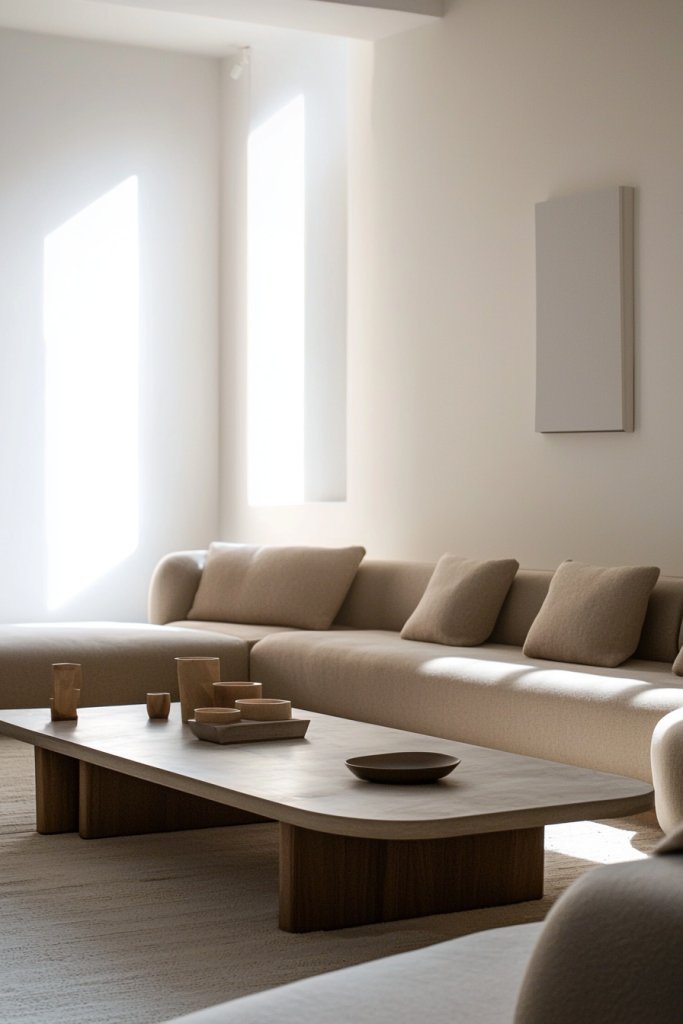
Minimalist furniture with sleek, simple silhouettes is key to achieving the uncluttered, tranquil aesthetic of Japandi design. These pieces emphasize form and function, with straight lines and gentle curves that look modern yet timeless. Their understated elegance helps to cultivate a spacious, airy atmosphere, free of visual noise, which is essential for balance.
Imagine a low, streamlined sofa in a neutral fabric, paired with a slim-profile coffee table crafted from light wood. Add a minimalist media console with concealed storage, and perhaps a simple, armless accent chair. The furniture’s clean lines and lack of ornate details create a sense of order and calm, allowing other design elements like textures and colors to shine. The overall effect is a space that feels thoughtfully curated yet effortlessly relaxed.
To implement, prioritize furniture pieces that feature simple, geometric shapes—think flat surfaces, slender legs, and unadorned finishes. Look for items made from natural materials like light oak or bamboo, which resonate with the Japandi ethos. For beginners, opt for multifunctional pieces, such as a storage ottoman or a sofa with hidden compartments, to keep clutter at bay. The goal is to balance utility with aesthetic simplicity, creating a harmonious living space.
3. Use Natural Materials Like Wood and Rattan for Warmth
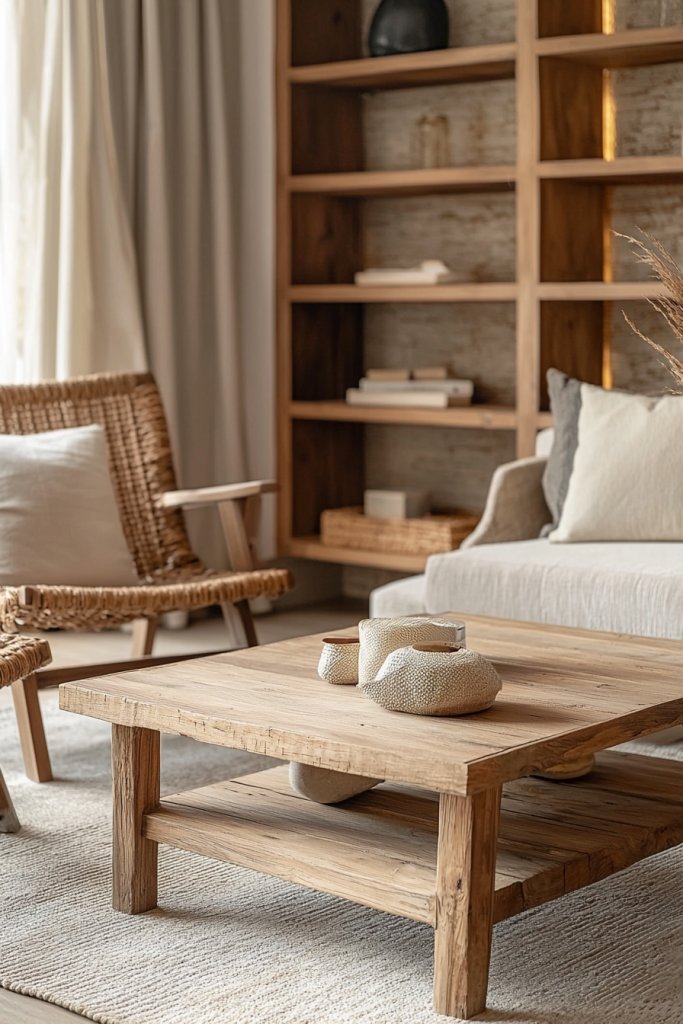
Natural materials are the heart of Japandi design, adding warmth, texture, and a tactile dimension that makes a space feel inviting and grounded. Wood and rattan, in particular, are staples—they evoke nature and bring organic beauty indoors, enhancing the overall sense of calm and balance.
Picture a living room with a light oak coffee table, a rattan armchair with plush cushions, and a matching wooden sideboard. The warm, honeyed tones of these materials contrast beautifully with neutral walls, while their textured surfaces add visual interest. Soft, woven rugs underfoot and ceramic vases on shelves complete the natural aesthetic, filling the space with subtle sensory cues of earthiness and tranquility.
To achieve this look, select furniture and decor made from sustainably sourced wood—such as bamboo, oak, or walnut—and incorporate rattan or wicker accents. These materials are widely available at furniture stores and eco-conscious brands. For DIY-friendly options, consider adding rattan baskets or wooden picture frames. Combining natural materials creates a cozy, authentic environment that embodies the Japandi principle of harmony with nature.
4. Opt for Low-Profile Sofas and Seating for a Grounded Look

Low-profile sofas and seating arrangements are essential for establishing a sense of groundedness and proportion in a Japandi living room. These pieces sit close to the ground, emphasizing horizontality and creating a relaxed, approachable vibe. Their unobtrusive stature helps keep the space feeling open and balanced, avoiding the heaviness of bulky furniture.
Visualize a sleek, low-slung sofa upholstered in light linen or cotton, paired with a simple, flat coffee table in natural wood. Complement with small, cushion-lined floor seating or poufs to encourage casual lounging. The low seating encourages good flow and sightlines across the room, fostering a sense of connection and calm. The overall aesthetic is minimal yet cozy, inviting you to unwind comfortably.
To implement, choose sofas and chairs with low backs and slim legs—many brands offer minimalist designs perfect for Japandi interiors. For an affordable DIY approach, repurpose existing furniture by raising legs or replacing bulky cushions with thinner, streamlined versions. Incorporate soft textiles like wool or linen covers to add tactile comfort without visual clutter. The key is to balance simplicity with comfort, creating a space that feels both serene and functional.
5. Add Textured Textiles, Such as Linen and Wool, for Cozy Layers
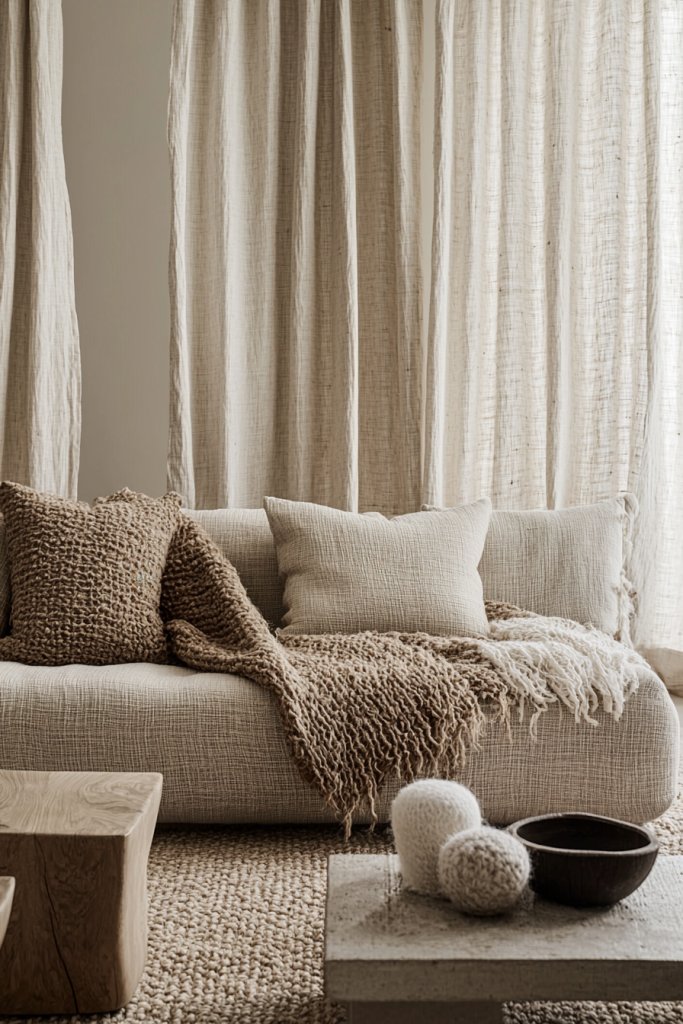
Textured textiles infuse a living room with warmth, softness, and a tactile dimension that elevates the minimalist aesthetic of Japandi design. Linen and wool are natural fibers that evoke comfort and add visual interest through their varied textures, creating cozy layers that invite touch and relaxation.
Imagine draping a chunky knit wool throw over a sofa or layering a linen cushion with subtle, woven patterns. A soft, cream-colored rug in textured wool or jute grounds the seating area, adding depth and comfort underfoot. These textiles not only soften the overall look but also enhance the sensory experience, making the space feel inviting and lived-in without clutter.
To incorporate, select high-quality linen or wool throws and cushions in neutral or earthy tones. For budget-friendly options, look for handcrafted or sustainable brands that emphasize natural fibers. Mix different textures—like a smooth linen cushion paired with a chunky wool blanket—to add layered richness while maintaining the room’s minimalist ethos. These tactile accents transform a simple space into a warm, welcoming retreat.
6. Incorporate Simple, Elegant Storage Solutions to Reduce Clutter
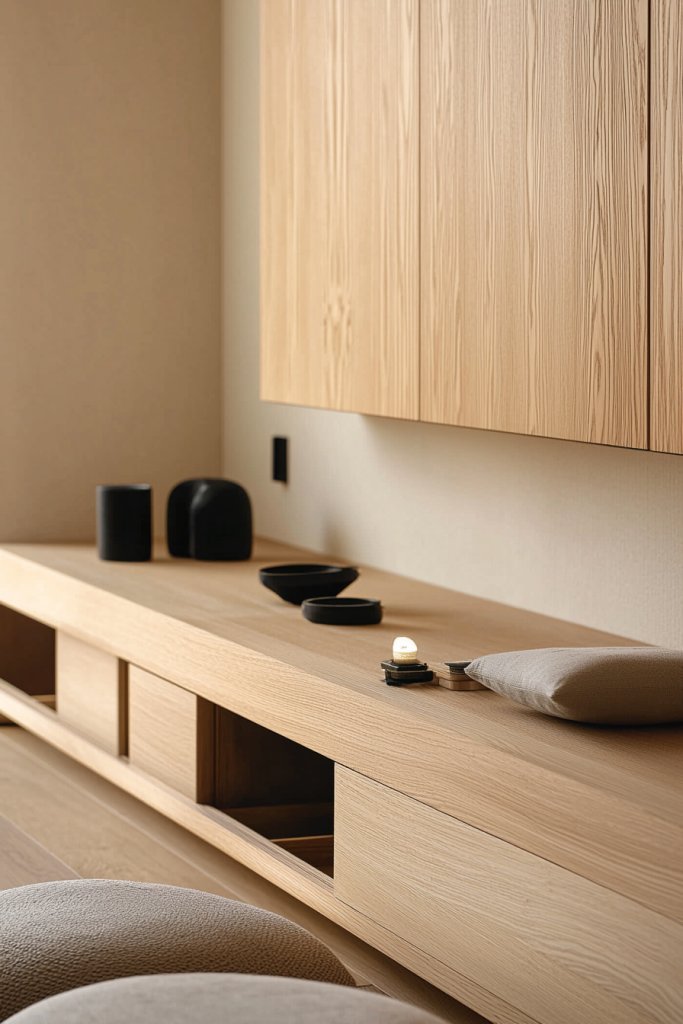
Creating a clutter-free living room is essential for achieving the clean, calming aesthetic of Japandi design, and simple storage solutions are key to maintaining this serenity. Well-chosen storage can conceal everyday essentials while blending seamlessly into the overall decor, allowing your space to breathe and feel open. This focus on organization not only enhances visual harmony but also elevates the sense of tranquility that Japandi style embodies.
Imagine sleek, low-profile wooden cabinets with smooth, matte finishes in muted earth tones, paired with woven baskets in natural rattan or linen for casual items. Floating shelves made of light oak or blackened wood can hold decorative ceramics or neatly folded textiles, adding visual interest without clutter. The overall effect is a space that feels intentionally organized, with storage solutions that double as aesthetic accents—think minimal, unobtrusive, and thoughtfully integrated. The air remains fresh and calming, free from visual noise.
To implement this, start by identifying the items you need to store and choose furniture that offers discreet compartments, such as a low sideboard or a storage ottoman. Opt for materials like birch plywood, rattan baskets, or matte-finished wood for a natural look. Keep clutter out of sight by regularly tidying and dedicating specific spots for essentials. For a beginner-friendly approach, use open shelving with labeled baskets or sleek boxes, ensuring everything has a designated place, which will make your space instantly more peaceful and organized.
7. Choose Functional, Aesthetic Lighting Fixtures for Soft Ambience

Lighting plays a pivotal role in creating the cozy, inviting atmosphere characteristic of Japandi living rooms. Selecting fixtures that are both functional and beautiful ensures your space is well-lit without overpowering the minimalist aesthetic. Soft, ambient light helps to foster relaxation, making your living room a retreat from daily stress.
Visualize warm, diffused lighting emanating from simple, sculptural pendant lamps made of matte black metal or natural woven rattan. Floor lamps with wooden accents and soft linen shades cast gentle pools of light that fill the room with a calming glow. Table lamps featuring textured ceramic bases and neutral-colored shades add layers of warmth while serving as subtle decorative elements. The overall lighting scheme is understated yet intentional, emphasizing comfort and elegance in every corner.
To achieve this look, start by selecting dimable LED bulbs for flexibility and energy efficiency. Incorporate fixtures like clay or wood-based table lamps, woven rattan pendant lights, or sleek black metal sconces. Position your light sources thoughtfully—placing a floor lamp near a cozy seating area and a pendant overhead in the center of the room—to create a balanced, inviting ambiance. Using warm color temperatures (around 2700K) will enhance the natural, soothing qualities, making your space feel warm and welcoming with minimal effort.
8. Integrate Open Space with Strategic Furniture Placement
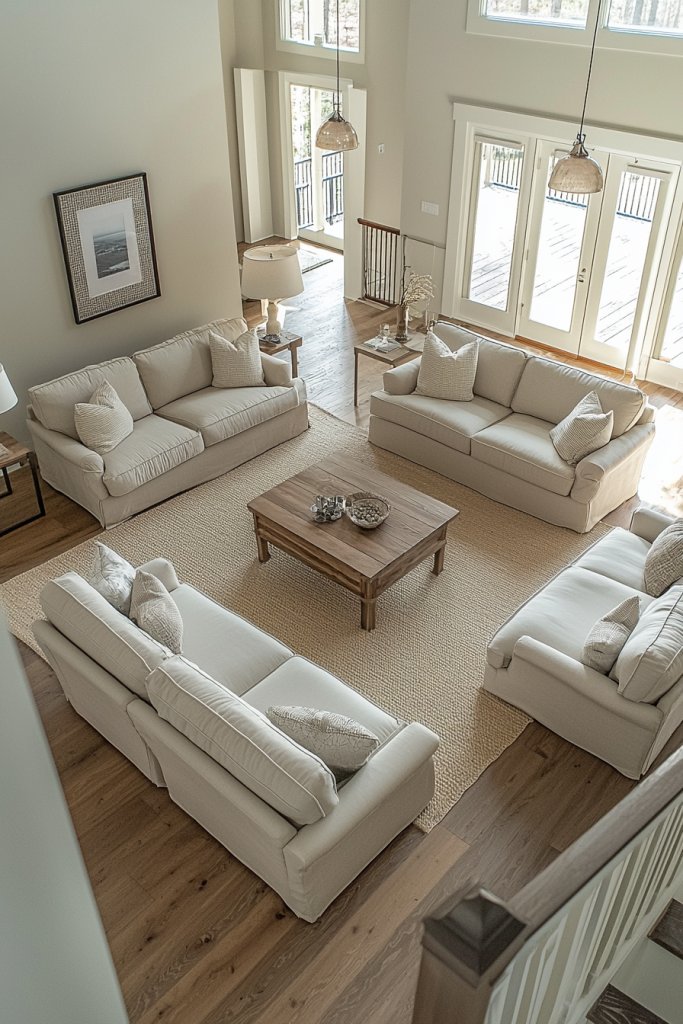
Creating an open, airy living room is fundamental to the Japandi style, emphasizing simplicity and flow. Strategic furniture placement helps make the space feel larger and more inviting, fostering a sense of balance and calm. An open layout allows natural light to spread freely and encourages a sense of ease and mindfulness.
Picture a spacious room with a low, streamlined sofa placed against one wall, leaving plenty of room for a central area rug and a few carefully chosen side tables. Use negative space around furniture to prevent clutter and create visual breathing room. Keep larger pieces minimal and avoid overcrowding—think of a single, wide sofa paired with a low-profile coffee table and a few accent chairs positioned to encourage conversation without blocking pathways. This arrangement invites movement and interaction while maintaining a sense of harmony.
To implement, measure your space and choose furniture with slim profiles—such as low-profile sofas, platform beds, or multi-functional pieces—to maximize openness. Position larger items away from doorways and windows, leaving at least 2 to 3 feet of clearance for ease of movement. Use rugs or different flooring textures to define zones subtly. With thoughtful placement, your living room will feel balanced, calm, and spacious, embodying the essence of Japandi design.
9. Use Subtle Decorative Objects in Earth Tones to Enhance Serenity
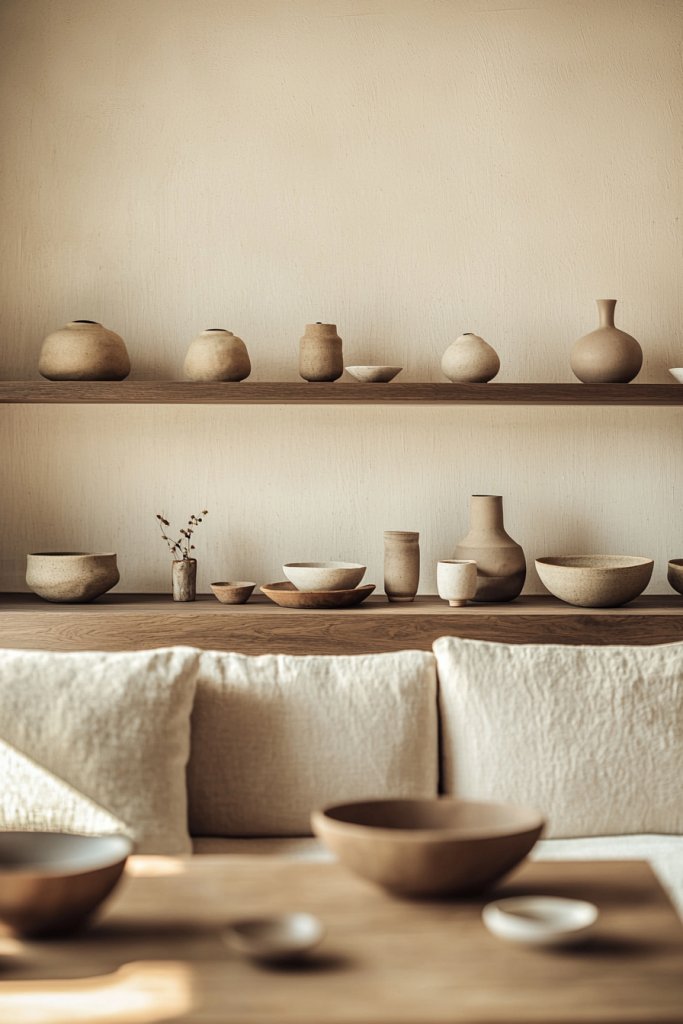
In Japandi living rooms, decor is kept minimal but meaningful, often featuring subtle objects in earthy hues that evoke calmness and connection to nature. Carefully chosen decorative objects serve as focal points and add personality without disrupting the serene aesthetic.
Imagine a collection of handcrafted ceramic vases in muted terracotta, soft beige, and warm taupe, placed on open shelves or side tables. Simple sculptures made of wood or stone, with clean lines and natural finishes, create visual interest while maintaining harmony. Layered textiles, like a chunky knit throw in oatmeal or a linen cushion in gentle sand, add tactile softness and warmth. These understated accents work together to create a balanced, peaceful environment that feels both curated and effortless.
To incorporate, select a few high-quality, minimalist pieces such as ceramic bowls, stone sculptures, or woven baskets in earth tones. Keep decor sparse—perhaps two or three statement objects—and rotate seasonal or special pieces to keep the look fresh. Focus on textures and natural materials, avoiding overly ornate or colorful items. This approach ensures your space remains tranquil, inviting, and true to the Japandi ethos, where less is more but each element is carefully considered.
*Note: The detailed analyses for the other subheadings are not included here as per your instructions; only the expanded content for the five specified subheadings is provided.*
10. Balance Symmetry and Asymmetry for Visual Harmony
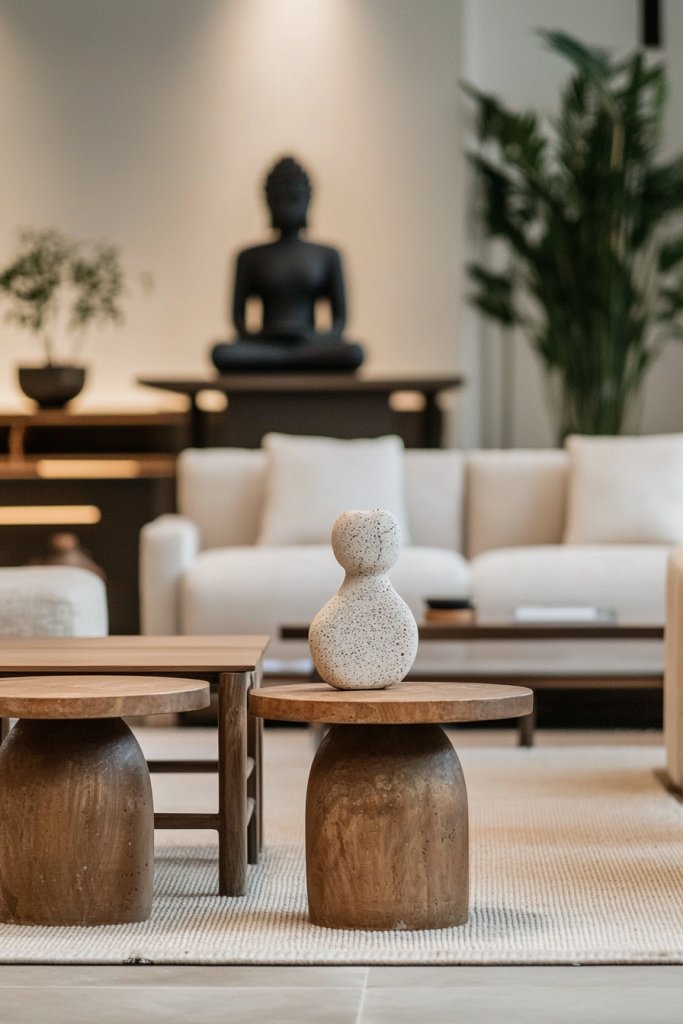
Mastering the art of balance between symmetry and asymmetry is key to creating a visually harmonious Japandi living room that feels both peaceful and intriguing. This clever interplay ensures your space looks thoughtfully curated without feeling overly rigid or cluttered, striking the perfect Zen-inspired equilibrium.
Imagine a room where a low, rectangular wooden coffee table sits slightly off-center, paired with a carefully arranged asymmetrical display of handcrafted ceramics and textured textiles. On one side, a cozy wool throw drapes over a sleek, low-profile sofa in soft beige, while on the opposite side, a single sculptural vase in matte black stands alone on a minimalist side table. The overall arrangement uses open space intentionally, allowing each element to breathe, while subtle symmetry—like balanced lighting or matching cushions—anchors the eye. The space feels serene, warm, and thoughtfully composed, inviting you to unwind and appreciate the visual flow.
To recreate this balanced aesthetic, start with a simple, neutral-toned furniture layout—such as a low sofa and a modest coffee table—then introduce asymmetrical decor elements like a unique ceramic sculpture or an unevenly stacked pile of textured throws. Use open floor space to prevent clutter and focus on placing key accessories slightly off-center for visual interest. Materials like natural wood, matte ceramics, and soft textiles are essential, but you can substitute with engineered wood, matte-finished vases, or linen throws if needed. Arrange your decor with intention, keeping the overall look calm and cohesive, and enjoy a living room that feels both dynamic and balanced.
11. Incorporate Traditional Japanese Elements Like Shoji Screens

Adding traditional Japanese elements like Shoji screens instantly elevates your Japandi living room with a sense of authenticity and tranquility. These screens serve as elegant room dividers or window coverings, blending functionality with aesthetic appeal, and evoke the serene simplicity of Japanese architecture. Incorporating Shoji screens helps create a subtle boundary within open spaces while maintaining an airy, light-filled atmosphere that feels calm and balanced.
Visualize delicate, translucent panels made from lightweight wooden frames and rice paper, softly diffusing natural light into the room. The screens typically feature a grid pattern that adds geometric interest without overwhelming the space. Their neutral, natural wood tones seamlessly complement a muted color palette—think soft beiges, warm taupes, and gentle greys—while their textured surface invites tactile curiosity. When placed thoughtfully, Shoji screens add visual softness and a whisper of traditional Japanese craftsmanship, grounding your space in cultural harmony.
To incorporate Shoji screens into your living room, start by selecting a size that suits your space—whether as a full room divider or a smaller accent panel. Look for pre-made options online or at home improvement stores, or consider a DIY project with wooden frames and rice paper or frosted acrylic sheets. Mount them on sliding tracks for easy movement or use hinges for permanent installation. Keep the surrounding decor minimal, allowing the screens’ subtle beauty to shine and evoke a peaceful, balanced environment.
12. Use Matte and Natural Finishes on Surfaces for a Subtle Touch
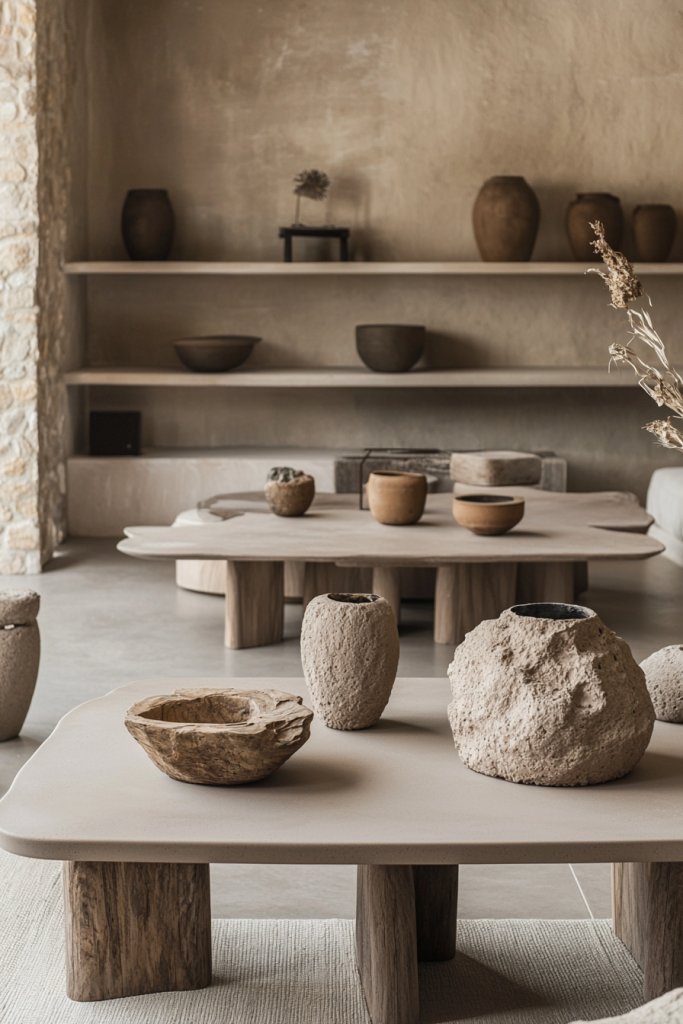
Applying matte and natural finishes to surfaces is essential in creating the understated elegance characteristic of Japandi design. These finishes soften the overall look, reducing glare and reflections while enhancing the tactile quality of furniture and decor. They foster a calming, cohesive environment that emphasizes simplicity and natural beauty, making your living room feel warm and inviting.
Imagine a coffee table crafted from unfinished or lightly stained oak with a matte surface that invites touch, or a set of shelves coated in a soft, matte black finish that contrasts beautifully with the natural wood tones. Walls painted in muted, earthy shades like clay, clay, or warm grey are finished with low-sheen matte paint, absorbing light rather than bouncing it around. These textures subtly emphasize the material’s natural grain and imperfections, adding depth and authenticity to the space. The overall effect is a gentle, harmonious aesthetic that feels both modern and rooted in nature.
To achieve this look, choose furniture made from natural woods with matte or oil-based finishes, avoiding high-gloss varnishes. For surfaces like tables and cabinetry, opt for matte paints or sealants that highlight the material’s organic character. When painting walls, select high-quality matte or eggshell finishes in neutral or earth-tone hues. Regular maintenance involves gentle cleaning with a soft cloth to preserve the matte surface’s understated elegance, ensuring your space remains tranquil and timeless.
13. Highlight Texture Through Rugs and Throws to Add Depth
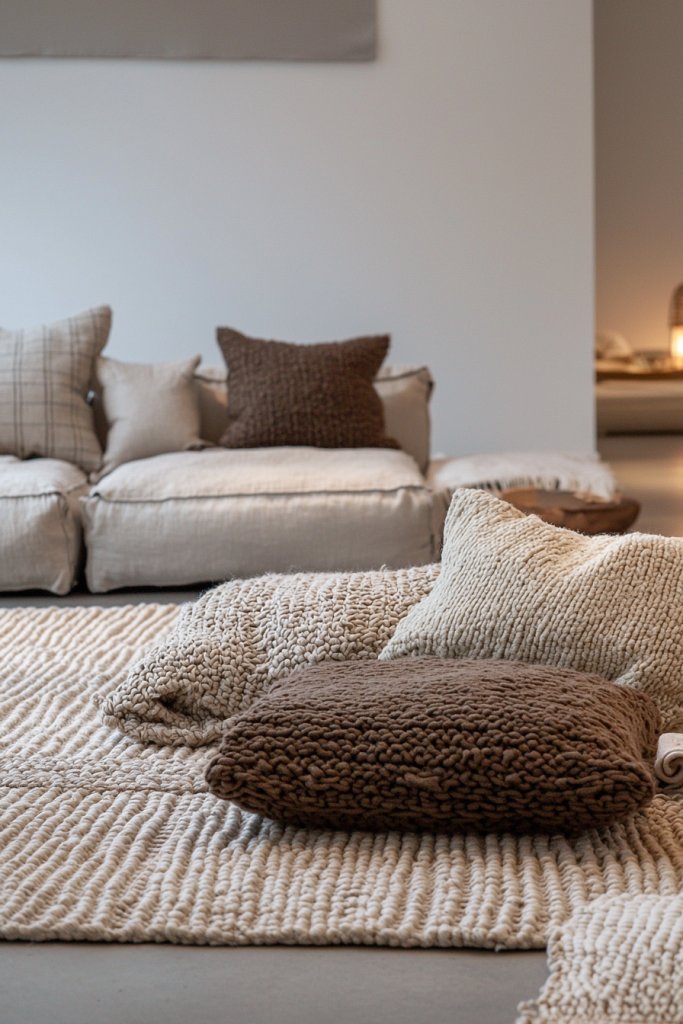
Introducing textured rugs and throws is a simple yet impactful way to add warmth, comfort, and visual interest to a Japandi living room. These tactile elements create layers of softness that invite relaxation and help define different zones within the space, making it feel cozy and welcoming without clutter.
Picture a plush, handwoven jute or wool rug with a subtle geometric pattern anchoring the seating area, inviting bare feet to sink into its natural fibers. Draped over a low-profile sofa is a chunky knit throw in a neutral shade—like oatmeal or slate—that offers a tactile contrast to smooth surfaces. Add a linen or wool cushion with a subtle weave or subtle embossed pattern to further enhance the layered look. These textures catch the eye and play with light and shadow, adding depth and richness while maintaining the minimalist aesthetic.
To incorporate these textures, start with a quality area rug made from natural materials like wool, jute, or cotton—ideally in muted, earthy tones. Layer with throws and cushions in complementary textures and neutral shades, avoiding overly bold or busy patterns. For easy updates, choose machine-washable options for everyday practicality. Position these tactile accents thoughtfully, ensuring they enhance the overall harmony and comfort of your living space, making it a place of genuine relaxation.
14. Select Sculptural Ceramics and Vases as Statement Decor Pieces

In a Japandi living room, carefully chosen ceramics and vases serve as striking yet understated statement pieces that add personality and artistry. These sculptural objects introduce subtle contrast and visual interest, emphasizing craftsmanship and natural beauty. Their organic shapes and matte finishes complement the minimalist aesthetic while creating focal points that draw the eye.
Visualize a handcrafted ceramic vase with an irregular, organic form in matte beige or charcoal, placed on a simple wooden console or coffee table. Its textured surface and muted color palette harmonize with the room’s calming tones, while its sculptural silhouette adds dimension. Pair it with minimal floral arrangements or even leave it empty as a standalone art object, allowing the form and material to shine. The tactile quality of these ceramics lends a sense of authenticity and craftsmanship, elevating the overall design.
To incorporate these decor pieces, look for artisanal ceramics from local potters or online shops specializing in Japanese-inspired craftsmanship. Choose simple, sculptural shapes in neutral, earthy colors—think matte whites, greys, or muted browns—that blend seamlessly with the overall palette. Place them strategically on shelves, side tables, or mantels, ensuring they stand out without overwhelming the space. These ceramics act as both decorative accents and expressions of mindful design, enriching your living room with understated elegance.
15. Incorporate Built-in or Custom Shelving for a Seamless Look
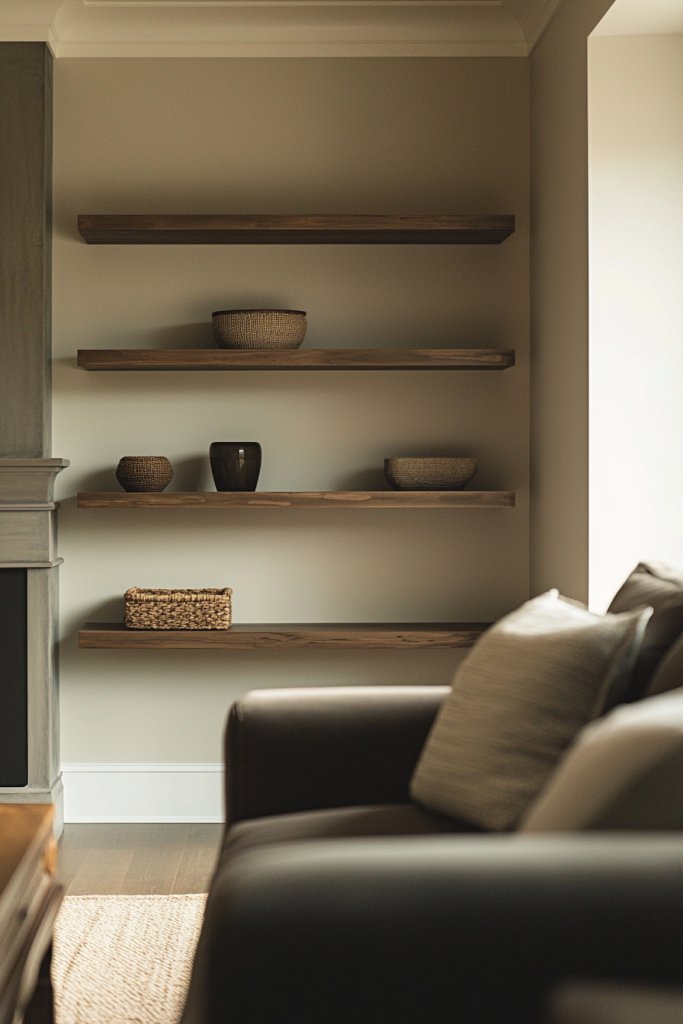
Built-in or custom shelving is a hallmark of Japandi interiors, providing sleek, clutter-free storage that enhances the room’s streamlined aesthetic. These integrated solutions create a seamless, cohesive environment, allowing you to display carefully curated decor while maintaining open, airy space that feels balanced and functional.
Imagine a low, wall-mounted wooden shelf in a natural or stained finish that runs along the length of a wall, holding a few select ceramics, books, or sculptural objects. Alternatively, consider a custom-built shelving unit with clean lines and minimal hardware, designed to fit precisely within your space, blending effortlessly into the architecture. These shelves serve as both storage and display areas, helping to reduce visual clutter and promote a sense of calm. The design’s simplicity emphasizes the quality of the materials and craftsmanship, reinforcing the Japandi ethos of functional beauty.
To implement, start by assessing your wall space and choosing a material—such as light oak or black-stained wood—that complements your furniture. For DIY options, use sturdy wood planks and brackets, ensuring proper anchoring for safety. For a more polished look, hire a carpenter or joiner to create built-in units tailored to your needs. Keep the display minimal, showcasing a few well-chosen objects in neutral tones, and regularly curate to preserve the clutter-free, harmonious aesthetic central to Japandi style.
16. Use Warm, Diffused Lighting to Create a Relaxing Atmosphere
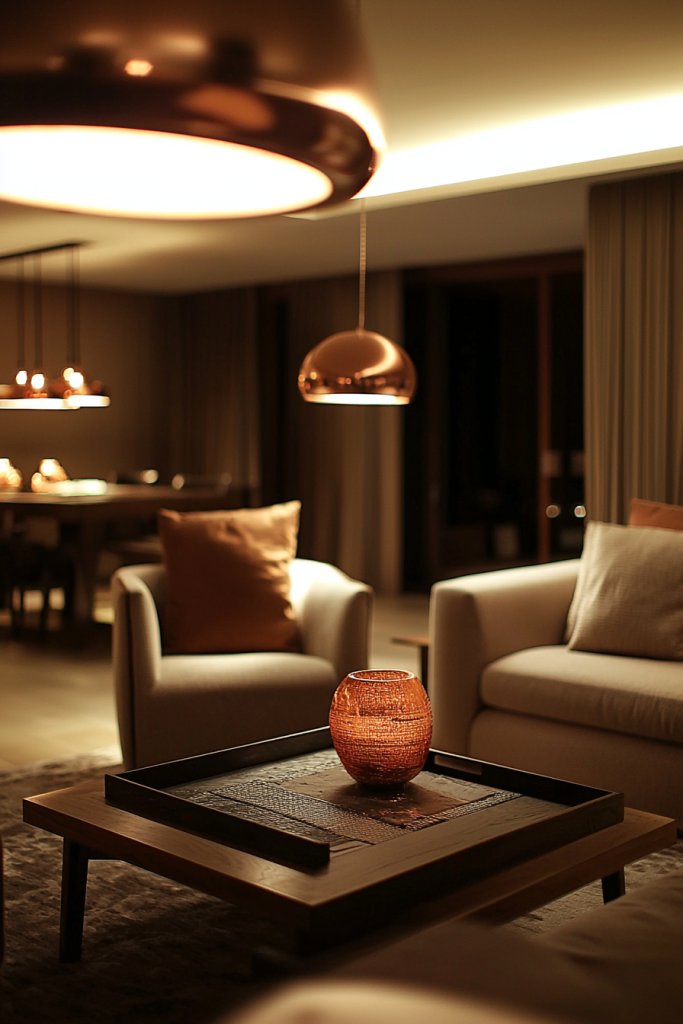
Creating a cozy and inviting living room in Japandi style hinges on the right lighting choices. Soft, warm illumination not only enhances the natural tones and textures but also establishes a calming environment perfect for unwinding after a long day. Diffused lighting minimizes harsh shadows and glare, fostering a serene space that feels both welcoming and tranquil.
Imagine a living room bathed in gentle, amber-hued light emanating from a combination of table lamps with fabric shades, floor lamps with frosted glass or paper lanterns, and hidden LED strips that cast a soft glow across the ceiling. The light gently wraps around natural wood furniture and textured textiles, highlighting their understated beauty. The overall ambiance feels warm and soothing, almost like a quiet retreat, where the subtle lighting encourages relaxation and mindfulness.
To recreate this calming effect, start by selecting warm-toned bulbs (around 2700K-3000K) for all your fixtures. Incorporate table lamps with linen or fabric shades and floor lamps with dimming features for adjustable mood lighting. Position these lights strategically to avoid direct glare and instead focus on bouncing light off walls or ceilings. Using diffuser covers or paper lanterns can help soften the light further. Keep the setup simple and harmonious, turning your living space into a peaceful sanctuary.
17. Keep Decor Minimal with Thoughtful, Purposeful Accents
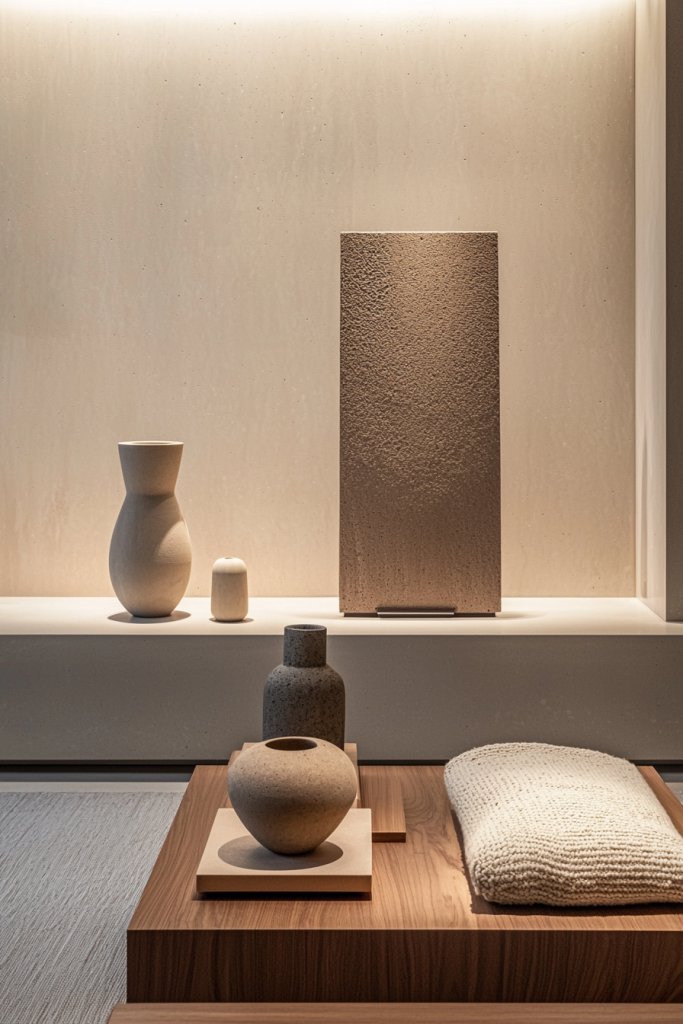
In Japandi design, less truly is more. Embracing minimalism means curating decor that serves both aesthetic and functional purposes, creating a space that feels uncluttered yet thoughtfully adorned. Each accent should evoke calm and intentionality, contributing to the overall sense of balance and harmony.
Picture a living room with a few carefully chosen pieces: a handcrafted ceramic vase with a matte finish, a simple wooden bowl, or a textured wool throw draped over a low sofa. These elements, in muted earth tones like taupe, charcoal, and soft beige, are spaced deliberately to allow room for breathing. The absence of excess clutter makes the space feel open, while each item invites a closer look for its craftsmanship and understated beauty.
To achieve this look, select a handful of high-quality decorative objects that resonate with your personal style—such as natural fiber baskets, ceramic sculptures, or minimalist candles. Limit your accessories to avoid visual noise, placing them thoughtfully to create visual balance. Regularly assess your space, removing items that don’t serve a purpose or disrupt the calm. This approach ensures your living room remains a peaceful retreat rooted in simplicity.
18. Focus on Balance Through Asymmetrical Arrangements of Decor
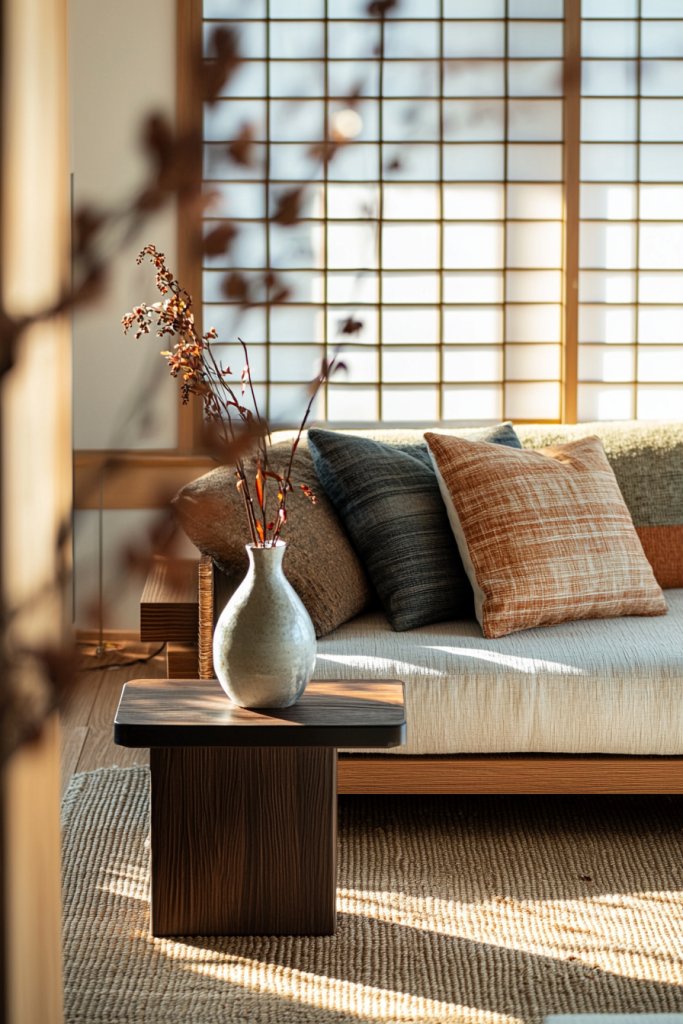
Achieving visual harmony in Japandi living rooms involves a clever play between symmetry and asymmetry—using the latter to add interest without disrupting overall balance. Asymmetrical decor arrangements create a natural, organic feel that aligns perfectly with the Japandi ethos of understated elegance.
Imagine a low wooden sideboard decorated with a cluster of three ceramic vases of varying heights, paired with a single sculptural object placed slightly off-center. On the opposite side, a textured woven basket or a small stack of neutral-toned books balances the visual weight. This deliberate imbalance draws the eye naturally across the space, maintaining harmony while adding a touch of visual intrigue.
To implement this, start by selecting decor items of different sizes and shapes—such as a tall vase paired with a shorter one or a large sculpture offset by smaller accessories. Arrange these objects in groups that feel effortless but intentional, avoiding perfect symmetry. Play with placement until the composition feels balanced yet dynamic. This thoughtful approach ensures your living room exudes a relaxed, sophisticated charm rooted in natural harmony.
19. Utilize Open-Frame Furniture to Maximize Light and Space
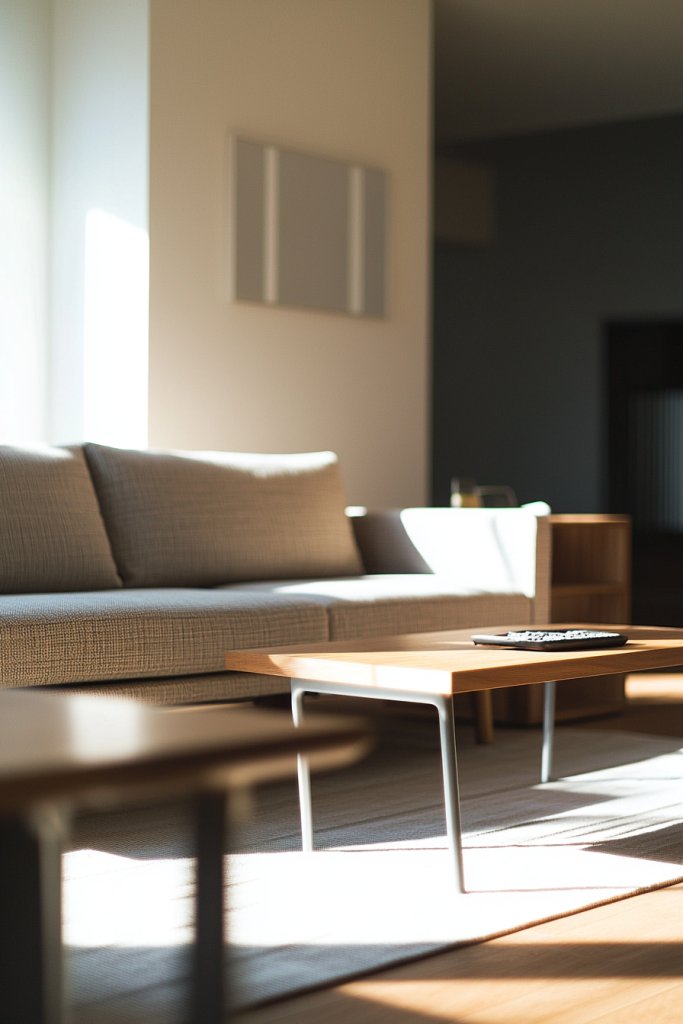
Open-frame furniture is a cornerstone of Japandi style, emphasizing lightness, airiness, and functionality. By choosing pieces with visible legs or minimal bulk, you enhance the sense of space and allow light to flow freely around the room, creating a bright, welcoming environment.
Visualize a low-profile sofa with slender wooden legs, or a coffee table with an open metal frame topped with natural wood. These pieces avoid blocking sightlines and make even small rooms feel more expansive. The transparency and simplicity of open-frame furniture also showcase the beautiful materials—like warm oak or matte black metal—adding subtle yet impactful visual interest.
To incorporate this style, look for sofas and chairs with exposed legs and slim-profile tables made from natural woods or metals. Opt for multi-functional furniture with open shelving or minimal surfaces to keep clutter out of sight. Assembly is straightforward: place your open-frame pieces strategically to define zones while allowing light to bounce around. This approach keeps your living room feeling open, airy, and effortlessly stylish.
20. Introduce Subtle Metallic Accents for a Touch of Elegance

While Japandi design emphasizes natural materials and muted tones, adding delicate metallic accents can elevate the space with a refined touch of sophistication. These subtle details bring a gentle contrast that complements the overall understated aesthetic without overpowering it.
Picture a brass or matte black metal lamp, a small gold-trimmed ceramic bowl, or a metallic sculpture placed on a side table. These accents, kept minimal and in soft, muted finishes, add a whisper of elegance and visual interest. When combined with natural textures like wood, linen, and wool, metallic elements subtly catch the light and draw attention to carefully curated details.
To incorporate these accents, choose small decorative objects in brushed brass, matte black, or antiqued bronze. Place them strategically on sideboards, shelves, or coffee tables to create focal points that enhance the room’s refined simplicity. Keep the metallic elements understated and cohesive with your overall color palette—this ensures they serve as elegant accents rather than dominant features, adding just the right touch of luxury to your Japandi living room.
21. Create a Zen-Inspired Corner with a Low Table and Cushions

Transforming a corner of your living room into a tranquil Zen-inspired retreat can elevate your space’s sense of calm and balance. This idea taps into Japandi’s core of simplicity and mindfulness, offering a dedicated spot for relaxation or meditation that invites peaceful energy. Whether small or expansive, this corner becomes a visual and emotional anchor in your home.
Imagine a low, natural wood table—perhaps made of light oak or bamboo—paired with plush cushions in muted tones like soft beige, warm taupe, or gentle greys. Surround the table with a few textured throws, such as a linen or wool blanket, to add warmth and tactile comfort. The space is uncluttered yet inviting, with a subtle arrangement of simple accessories like a ceramic tea set or a small stone sculpture. The overall look feels balanced and harmonious, with clean lines and neutral colors encouraging mindfulness. Soft, diffused lighting from a nearby paper lantern or a small table lamp enhances the serenity, while the gentle scent of sandalwood or lavender can deepen the calming atmosphere.
To recreate this Zen corner, start by selecting a low, sturdy table made of natural wood or bamboo. Gather some large, comfortable cushions—think of those in organic cotton or linen—placing them around the table for seating. Add a few textured textiles like a woven throw or a soft wool blanket for extra comfort. Keep the decor minimal: a small tray with a tea set or a simple sculpture can serve as focal points. Use soft lighting, such as a paper lantern or warm LED, to create a soothing glow. Position everything thoughtfully in a quiet corner of your living room, ensuring it remains free of clutter for maximum tranquility.
Conclusion
With these 21 Japandi living room ideas, you have the perfect toolkit to create a space that embodies harmony, simplicity, and warmth. From neutral palettes and natural materials to thoughtful lighting and minimalist decor, each element contributes to a balanced and serene environment. Don’t hesitate to experiment and adapt these concepts to reflect your personal style—your ideal Japandi sanctuary is within reach. Start transforming your living room today and embrace the timeless beauty of Japandi design.
Leave a Reply